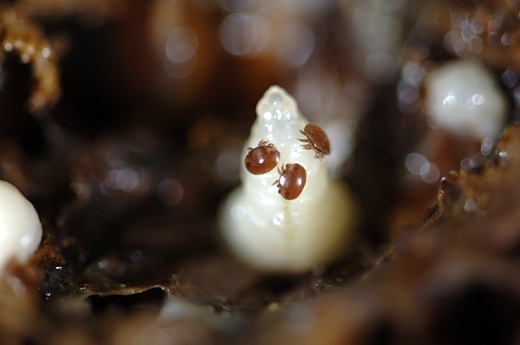 Image above: A pre-pupa drone being attacked by three varroa mites. From (http://www.scienceimage.csiro.au/mediarelease/honeybees.html).
Image above: A pre-pupa drone being attacked by three varroa mites. From (http://www.scienceimage.csiro.au/mediarelease/honeybees.html).
Researchers studying honey bees in Hawai'i have found that the varroa mite, besides weakening and killing bees itself, also spreads a devastating bee-killing virus. Indeed, in places where the mite has spread, infections of the deformed wing virus (DWV) have increased from being in 10% to 100% of the bees in infected hives. An international team of researchers, including two from the University of Hawaii, used the relatively new infestation of varroa mites in the Hawaiian Islands to study how the virus spreads along with the mite.
Their work is in the June 8, 2012, issue of Science and the June 7 issue of Science Express. In other parts of the world, the combination of the mite and the virus has led to colony death. That has also happened in Hawaii, but only after the mites have been in place for a long period to time--two years or more.
Varroa mites are sucking pests that live off the blood of bees. They will often begin feeding on bees that are still in the larval stage. The DWV can spread on its own, but is much more effectively spread by the mite, which can inject the virus directly into the bee's body.
The researchers also found that as the mites spread the virus, they have also played a role in the genetics of the virus, resulting in significantly lower viral diversity. In varroa-infected colonies, only a single strain of DWV is now dominant, they found. The varroa mite is in all the state's major bee-farming islands except Kauai.
A 2005 study by University of Pennsylvania Diana L. Cox-Foster and Xiaolong Yang found that varroa mite infestations reduce bees' immune response, making them more susceptible to infection. Some reports indicate that in the absence of the mites, bee hives can sustain infection with DWV, but that instances of actually deformed bees increase when mites are present--perhaps because of the mite-induced reduced immune response.
There are signs of hope with regard to the mite, whose scientific name is Varroa destructor. Some strains of honeybees have a self-cleaning gene that causes them to groom the mites off themselves. And, researchers in both Great Britain and the United States are studying fungi that may help control varroa mites.
A U.S. Department of Agriculture report on this is here: ( http://www.ars.usda.gov/is/AR/archive/oct04/bees1004.htm).
The Hawaii mite-virus work paper is:
"Global honey bee viral landscape altered by a parasitic mite" by Steven J. Martin and L. Brettell, University of Sheffield; A.C. Highfield and D.C. Schroeder, Marine Biological Association of the United Kingdom; E.M. Villalobos and S. Nikaido, University of Hawaii; G.E. Budge and M. Powell, Food and Environment Research Agency, York, UK.
See also: Ea O Ka Aina: They're Here! 5/31/12 Ea O Ka Aina: Pesticide and Beehive Collapse 4/5/12 Ea O Ka Aina: Nicotine Pesticides and Bees 12/13/11 Ea O Ka Aina: Neonicotinoid pesticides kill bees 1/24/11 Ea O Ka Aina: Let's talk about bees 1/18/11 Ea O KA Aina: Mystery of westside bee decline 7/5/10 .
No comments :
Post a Comment